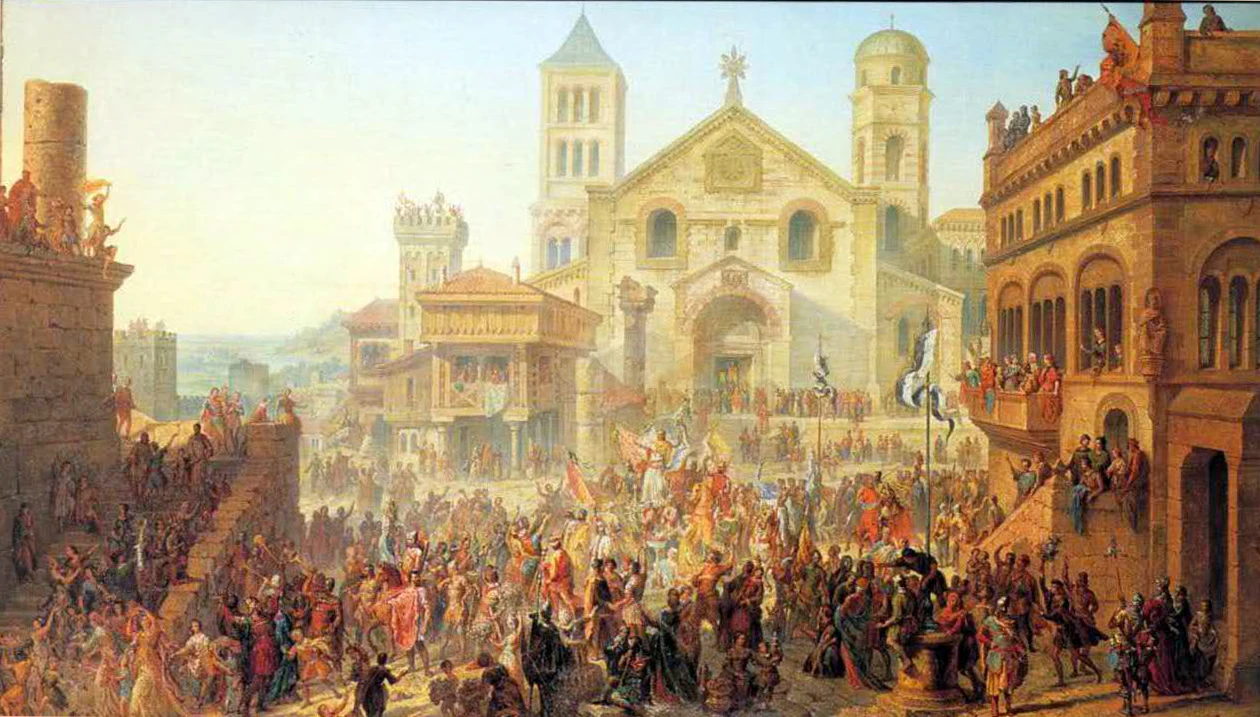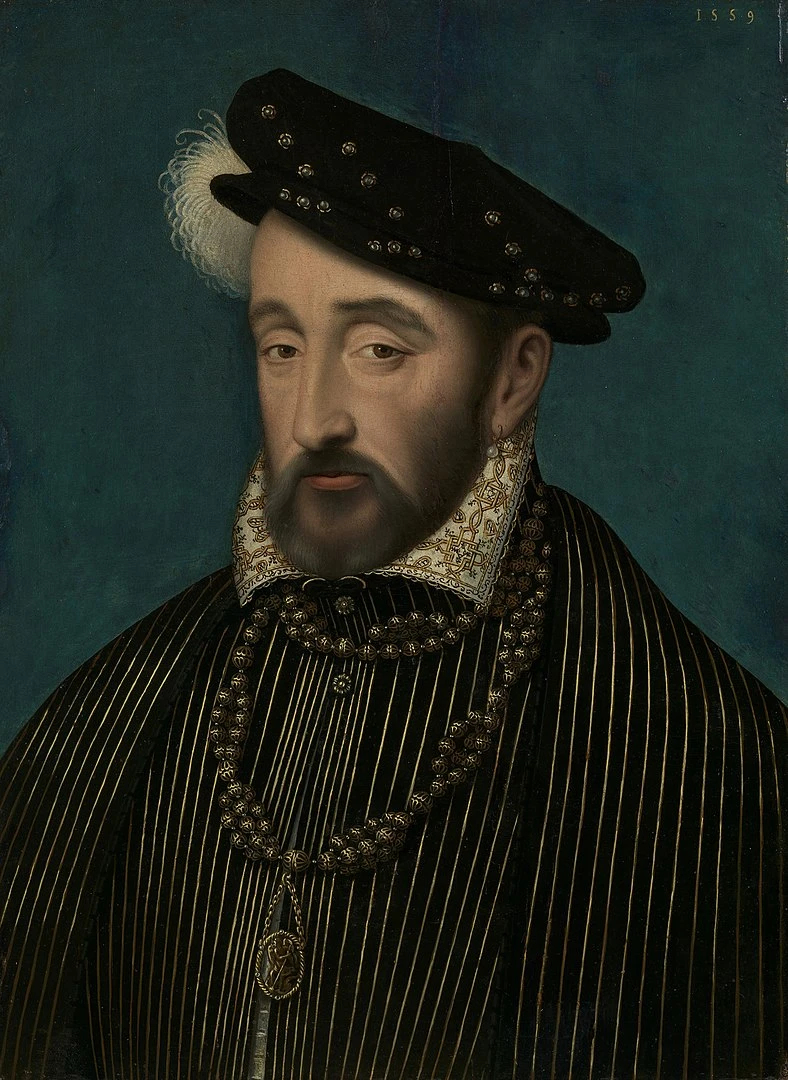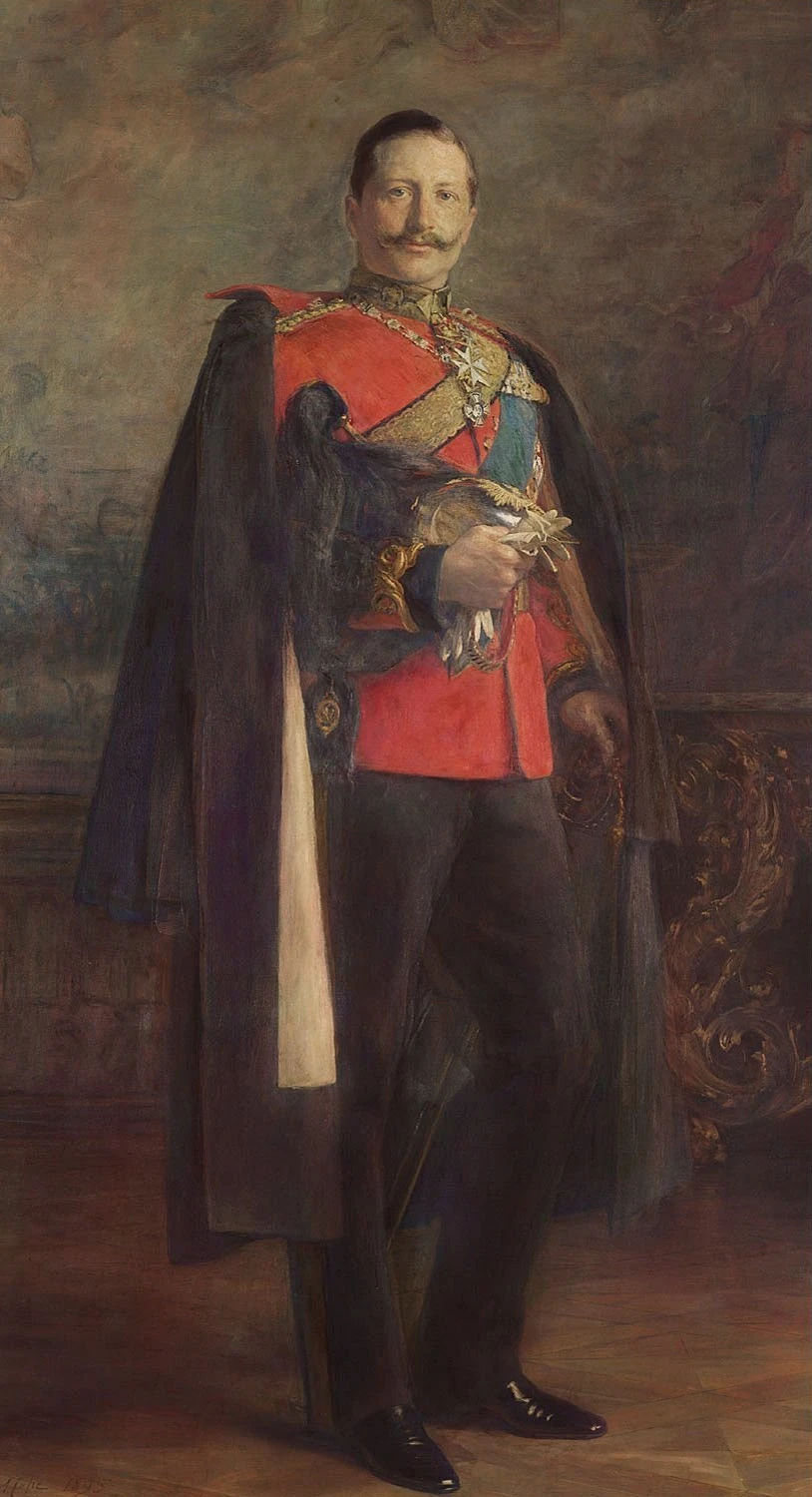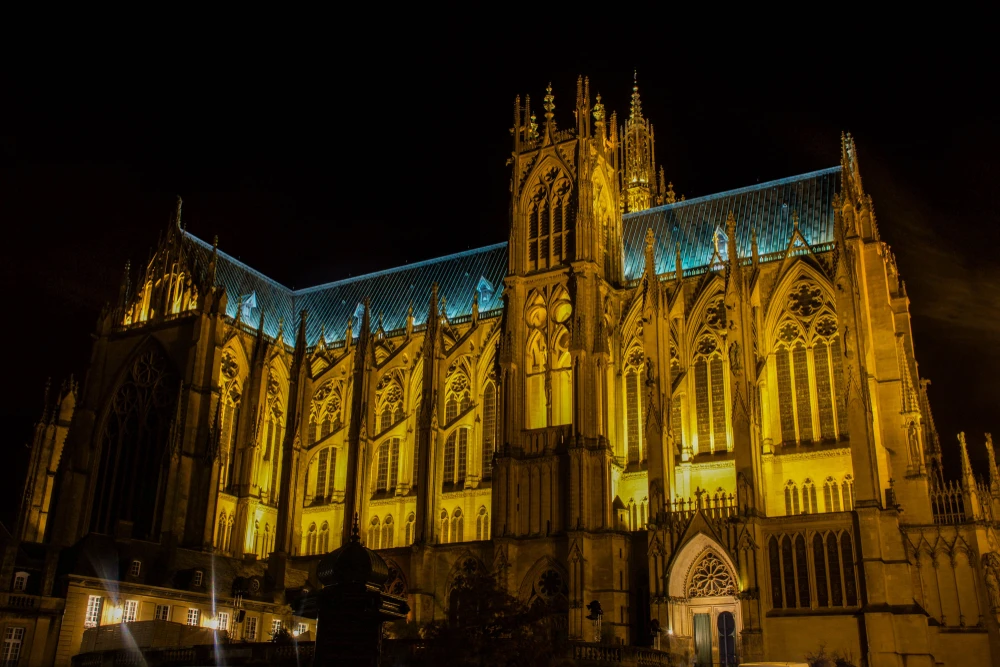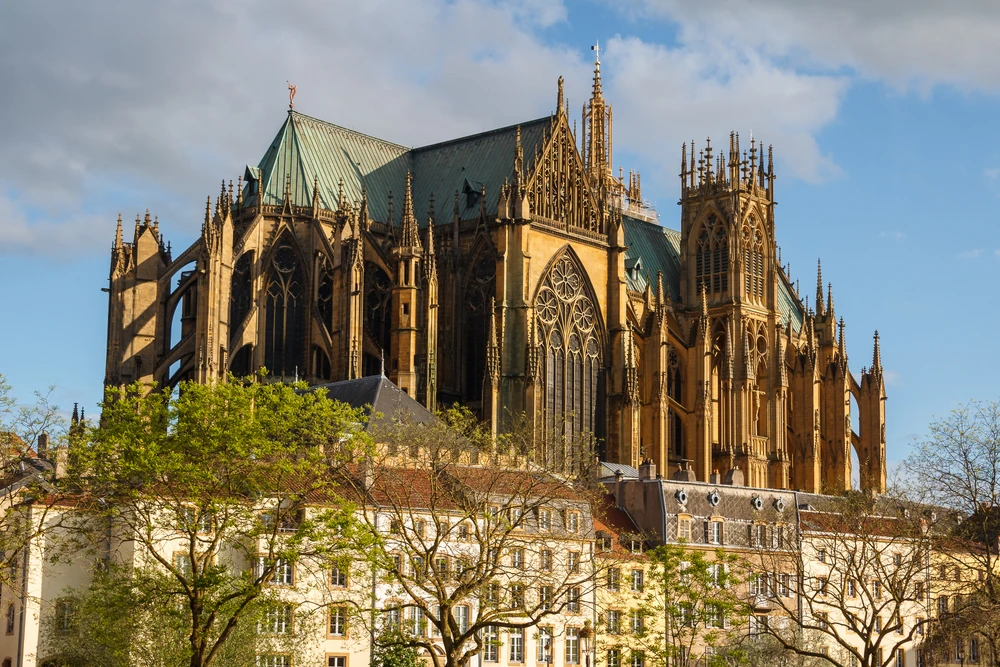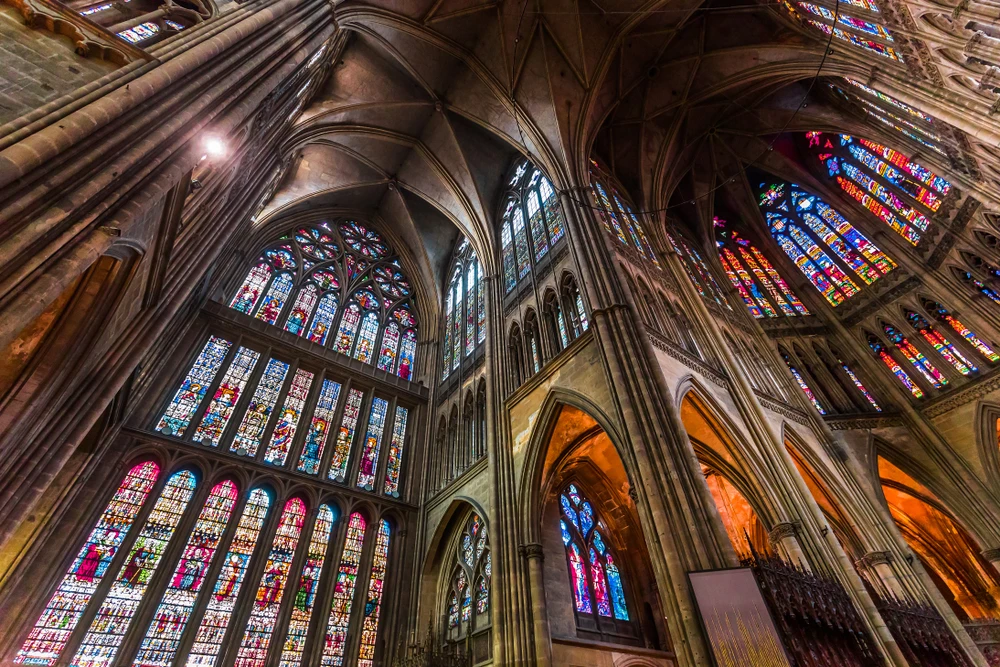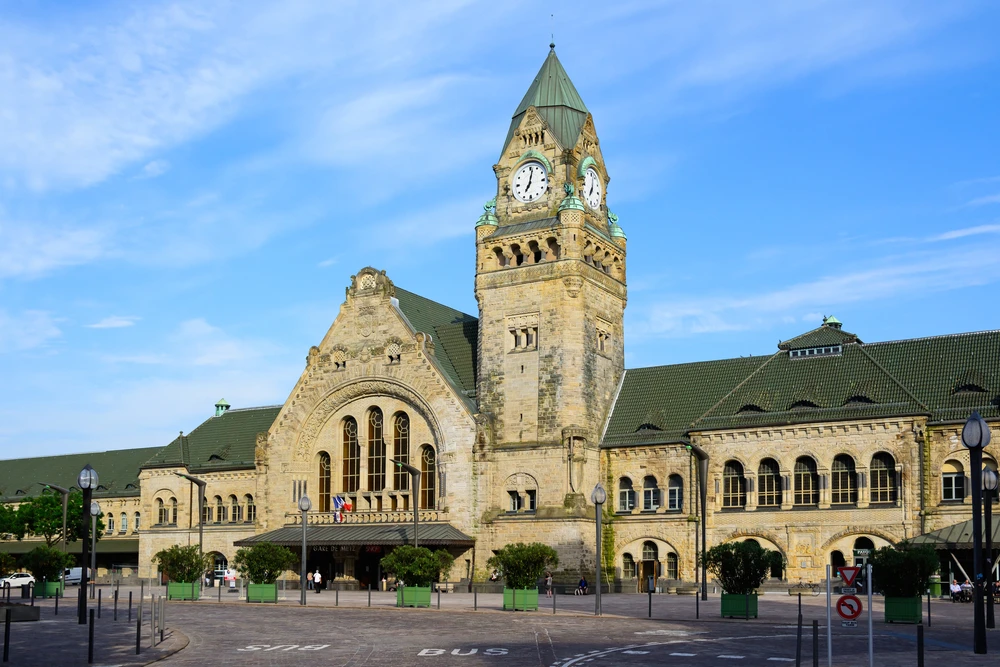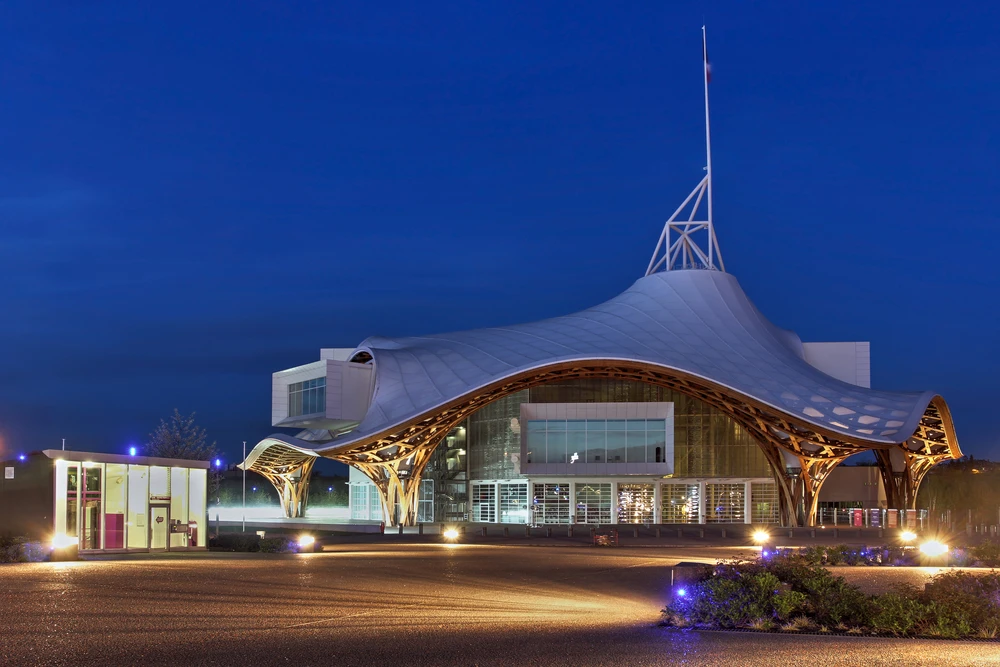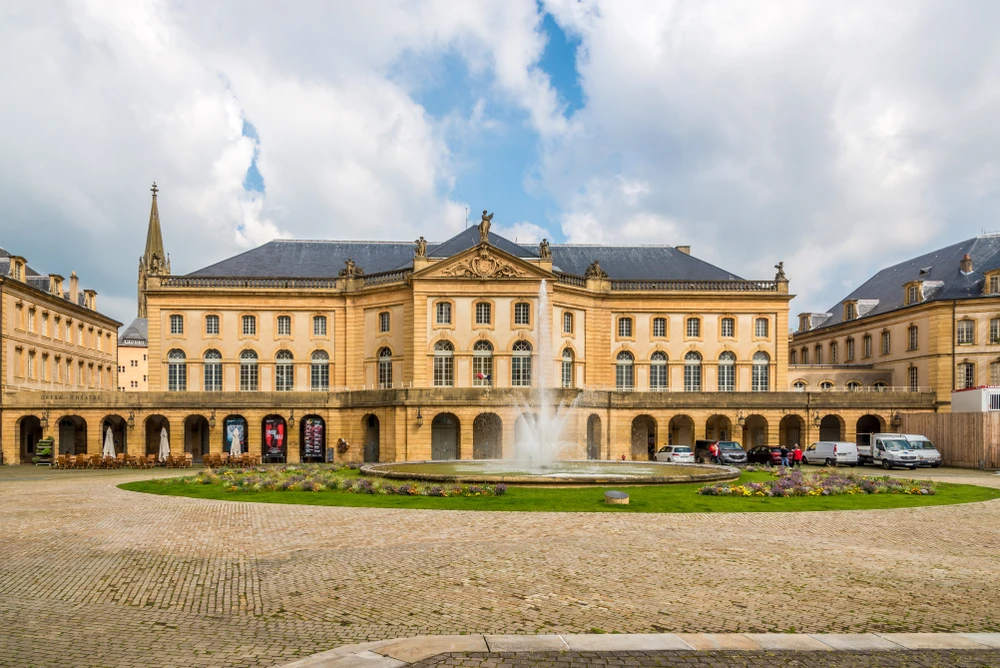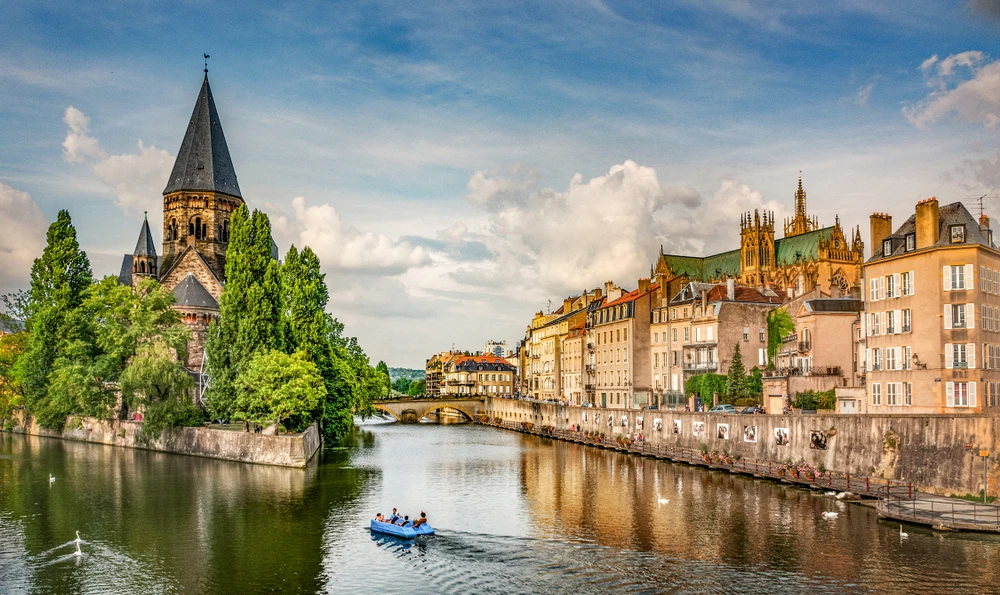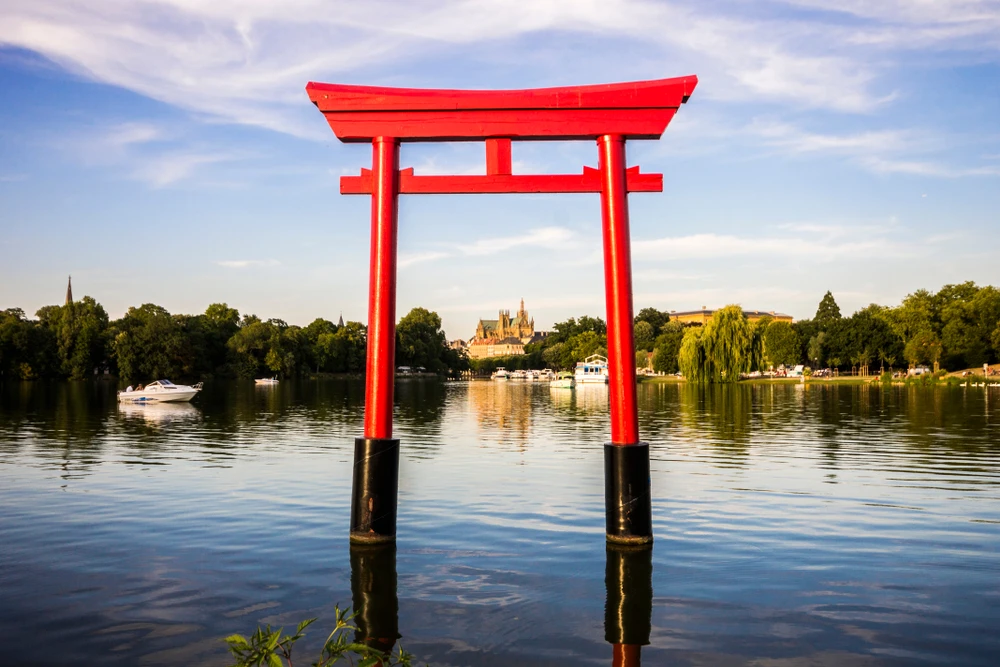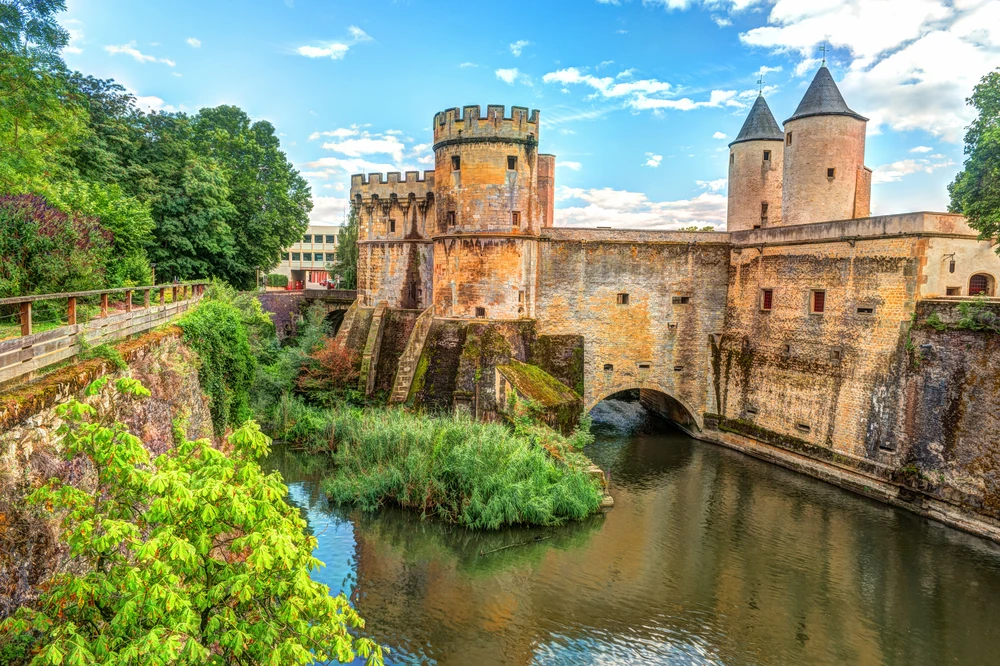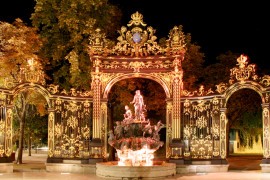Brief history of Metz
Gallic capital and city of the Empire
Illustration chosen by Monsieurdefrance.com : facsimile of the Table of Peutinger by Conradi Millieri 1888.
The city is very old. It was the capital of the Gallic Mediomatrici (they fought Julius Caesar). It was called Divodorum, and appears under this name on the Peuttinger table, the oldest map of Europe. When it became Gallo-Roman, the Gallic city was adorned with large streets and facilities such as a basilica (which became the church of Saint Pierre aux nonnais, the oldest church in France) or an amphitheater (which gave its name to the amphitheater district). Evangelized in the 4th century by Saint Clement (who is said to have chased away a dragon named Graoully that was devouring children), it was ravaged by Attila (who executed the bishop and the population), it became the capital of Austrasia at the beginning of the Middle Ages and the seat of a brilliant court that is told (among other things) in the Cour d'Or museum.
City of Paraiges
Illustration chosen by Monsieurdefrance.com: the foundation of the Republic of Metz by the bourgeois. Painting by Jules Migette, 1862.
A commercial and bourgeois town, it became very important in the Middle Ages. Business was done there, as witnessed by the Place Saint Louis and the arcaded buildings that housed the Lombard money changers. Great dynasties of merchants took the city in hand and it was largely administered. The old town center is full of the private mansions of these families called "les paraiges", often fortified, which shows that politics was never easy.
Key to the Kingdom of France
The city was more or less annexed by King Henry II of France, at the end of the "Chevauchée d'Austrasie" in 1552. He made it a kind of protectorate. The city became definitively French in 1648. It was fortified by the Marshal of Vauban who nicknamed it "the key to the kingdom". We can still see the traces of it with, among others, the Arsenal (now a superb concert hall) or the citadel (a famous hotel).
Illustration chosen by monsieurdefrance.com : Henri II painted by François CLOUET in 1559 (7 years after the Austrasian Ride).
The 18th century
Capital of the three bishoprics (Metz, Toul and Verdun), the city was embellished by Marshal de Belle-Isle who had the Place d'Armes built, near the Cathedral, and a magnificent town hall. He also had the Place de la Comédie created, a delightful 17th-century ensemble along the river, named after the Comédie,the municipal theater of Metz, the oldest active theater in France.
Illustration chosen by monsieurdefrance.fr : Charles Louis Fouquet, Marshal of Belle-Isle, in 1748 by Quentin de la Tour.
Annexed by Germany in 1871
The siege of Metz, the soldiers' farewell to their officers, painted by Théodore Devilly in 1874. Several tens of thousands of French soldiers were taken prisoner by the Prussians that day. By Oktobersonne - Personal work, CC BY-SA 4.0, https://commons.wikimedia.org/w/index.php?curid=68322354
After the defeat of 1871 (and in particular the disastrous siege of Metz which was lost by Marshal Bazaine), the city was attached to the new German Empire, born in the Hall of Mirrors at Versailles, despite the protests of the Moselle and Alsace deputies at the National Assembly during the presentation of the treaty of Frankfurt. Kaiser Wilhelm II made Metz one of his favorite cities and did not hesitate to embellish it by renovating the cathedral and building the enormous Metz train station with its double platforms, which was to be of great importance during the First World War, since Metz, an impregnable fortress, was also an easy arrival and departure point for German troops, whereas in France, the stations in the vicinity had only one platform, which slowed down the arrival of soldiers. The city was returned to France after the war, in 1918. It was annexed again in 1940 and returned to France in 1945. The 19th century is the time of construction of the imperial district which aligns the buildings of Romanesque, Gothic or Renaissance style which were in the taste of the time. The houses are quite extraordinary and worth a visit.
Illustration chosen by monsieurdefrance.com Emperor William II in 1885 by Arthur Stockdale Cope. The emperor loved Metz very much and wanted to embellish it.
European city
Metz has remained a very commercial city. Its rich past has made it a very beautiful city, which should be discovered on foot to enjoy the many original facades and public buildings. You can find some nice restaurants. It is the city of Robert Schuman, one of the fathers of Europe. It is in the heart of Europe, between Luxembourg, Germany, Belgium not so far away, and France of course.
The 7 wonders of Metz for Monsieur de France:
1 Saint Stephen's Cathedral
The Saint Etienne de Metz cathedral seen by night. Photo chosen by monsieurdefrance.com : Shutterstock.com
Even if the city already existed in the Gallic times (it was called Divodorum Mettensis) as the capital of the Mediomatrici, it built its history as a city of Empire under the leadership of the bishops of Metz. The Cathedral embodies this history. It dominates Metz. It was born from the fusion of two churches close to each other. Very symbolic of the soul of the city, the watchtower, the tower of "la mutte" (from the ameute because it warned of danger) is integrated into the cathedral (it is 88 meters high without the spire, 93 with the spire). It rarely rings on the fly, except for big events. It rang for the hundredth anniversary of the end of the First World War in 2018.
The Cathedral of Metz is made of Jaumont stone. Photo chosen by monsieurdefrance.com: Lev Levin / Shutterstock.
It is made of jaumont stone, the golden yellow stone of the Messin country, very typical. To see in particular the entrance portal, which one would believe of the Middle Ages, and which in fact dates from the end of the XIXth century in replacement of a classical XVIIIth portal which had itself replaced the portal of the Middle Ages. The emperor William II, at the origin of the works, is represented as the prophet Daniel at the entrance and he inaugurated his statue and the end of the works in 1903 (his moustache was erased to make people forget the German emperor when Metz became French again).
In the cathedral of Metz, the stained glass windows are spectacular do not miss them. Photo chosen by monsieurdefrance.com: Shutterstock.
One of the originalities of the cathedral is the enormous surface of stained glass windows which constitute it: 6492 M2 of stained glass windows in all. Some of them date back to the Middle Ages (12th century) and are signed by Marc Chagall . Take the opportunity to visit the old Metz around. The covered market, located just opposite, is great (and very greedy). You can have a drink not far away, on the place de Chambre, or on the place Saint-Louis.
Situation:
Place d'armes, 57 000 METZ.
2 the Metz train station
The Metz train station is the most beautiful station in France. Photo chosen by Monsieurdefrance.com : Shutterstock.com
Elected several times "most beautiful station in France", it is now out of competition. It is true that it is imposing. Of neo-Romanesque style, it was born from the will of the emperor Guillaume II. Built in 3 years, from 1905 to 1908, according to the plans of Jurgen Krüger, it is 300 meters long and 40 meters high for the clock tower. To see, notably, the bas-reliefs of the facade and the interior. Sculpted in the style of the Middle Ages, they often represent scenes of the 20th century such as workers, travelers, a telegraph operator ... On the facade, a knight carries a shield. He has changed his head several times. The Germans created him with a medieval helmet in German style, the French replaced his head with another helmet considered more French.
Also worth seeing, when it is open, are the emperor's apartments and notably the extraordinary stained glass window representing Charlemagne. It is the heart of the "imperial" district since it dates from the German Empire. It is one of the rare districts of German architecture of the 19th century in Europe, since those of the large German cities were bombed in 1945 and, for many, destroyed. The amazing governor's palace, located near the arsenal, also dates from this period and looks like something out of a fairy tale.
Situation:
1 place du Général de Gaulle, 57 000 METZ.
3 the Metz pompidou center
The Metz Pompidou Center at nightfall. Photo chosen by Monsieurdefrance.com : Shutterstock.com
It is the most recent monument in Metz since it was inaugurated on May 12, 2010. Decentralized from the Centre Pompidou in Paris, the Centre Pompidou Metz is a museum of modern art. It was born from the imagination of Shigeru Ban, Jean de Gastines and Philip Gumudjian. Its Chinese style is quite surprising and elegant. To see, on the architectural side, the interlacing of the wooden beams.
Situation:
Center Pompidou Metz, 1 parvis des Droits de l'Homme, 57 000 METZ
4 the place de la Comédie
The Place de la Comédie in Metz is typical of the 17th century. Photo chosen by monsieurdefrance.com Shutterstock.com
Here is a place that tells very well Metz since it is located along the river, on an island, the island of the small Saulcy, and that it presents two times. First of all, the 18th century, since it is in 1732 that the Place de la Comédie was born and its classical facades which are beautifully rounded to advance on the square. The Opera-Theatre of Metz is in the center. It was inaugurated in 1752 and since then it is still in activity. It is a very beautiful Italian-style theater. On the right of the theater is the prefecture of the Moselle, former seat of the intendance. And on the left is the Temple Neuf, built in 1908 in neo-Romanesque style, which can be seen from afar.
The new temple of Metz seen from the back, it overlooks the Place de la Comédie in Metz. Photo chosen by monsieurdefrance.Com : Shutterstock.com
Situation:
Place de la Comédie 57 000 METZ.
5 The water body
Born from the will of the scientist, biologist and writer Jean Marie Pelt, it was created during the construction of the A31 freeway which passes nearby. A water reservoir was built on a wetland to form a kind of lake. The lake, inaugurated in 1974, is part of the soul of Metz. It is more than 7 hectares in size, you can often see signs, and you can discover, from the lake, one of the most beautiful views of Metz. You can practice kayaking, rowing, skateboarding too. You can eat there.
Situation:
Promenade Hildegarde, 57050 LONGEVILLE LES METZ.
6 The German door
It is the most beautiful heritage of Metz in the Middle Ages, with the church of Saint Pierre aux Nonnains (the oldest church in France since it dates from the 4th century), the Camoufle tower (remnant of the ramparts) and the Templars' chapel. Built in the 13th century, it is called "Porte des Allemands" because it led to the hospice of the Teutonic Knights, Knights Hospitallers, which was not far away. Integrated by Vauban into the ramparts of Metz, it survived their destruction and became a museum in 1900. It has been entirely restored recently.
Situation
Porte des allemands, Boulevard André Maginot, 57 000 METZ.
7 the Cour d'Or museum
Founded in 1839, it tells the history of Metz, and is very rich in Gallo-Roman and medieval archaeological collections. While visiting it, you will also discover the ancient Roman baths, the old fortified granary, which served as a reserve for the inhabitants, especially in case of siege, and a magnificent baroque chapel. It is really worth the detour, it is one of the most important museums of all the East of France with 3500 M2 of exhibition .
Situation
Musée de la Cour d'or, 2 rue du Haut poirier, 57 000 METZ.
Destination and website information
Metz is located in the Moselle department, historical region of Lorraine, and administrative region of the Grand-Est. It is populated by a little more than 200,000 people from Metz .
By car
330 kms from Paris on the A4 (3H20), 60 km from Luxembourg (50 mn), 469 kms from Amsterdam and 800 kms from Berlin.
By train :
1H30 from Paris Gare de l'Est
By plane
Metz Nancy Lorraine airport in Louvigny (37 kms), Luxembourg airport (60 km).
The websites:
The official website of the city of Metz.
The website of thetourist office of Metz.


